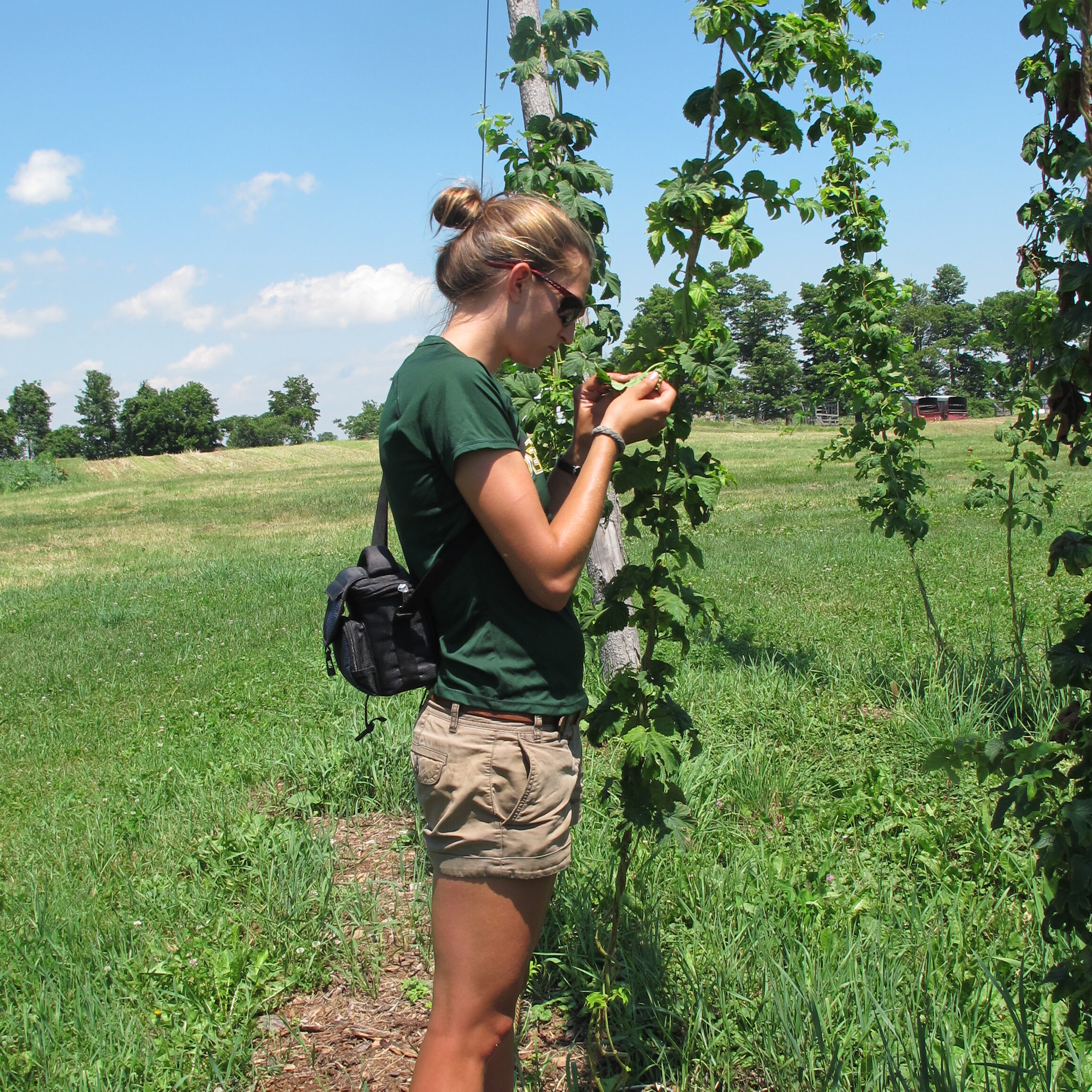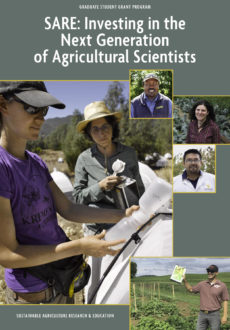Finding Better Ways to Battle Bugs
Lily Calderwood, University of Vermont
When it comes to managing pests, many growers are working to find ecological strategies that reduce pesticide use and favor beneficial insects and pollinators. As desirable as this approach is, it also takes greater understanding of pests, crops and the local environment.
So, while a graduate student at the University of Vermont, Lily Calderwood sought to provide growers with the information they need to implement ecological pest control strategies, by studying how the state’s expanding hops industry could reduce pesticide use through beneficial insects and flowering cover crops. She received a 2012 SARE Graduate Student grant to evaluate how cover crop plant species diversity and flowering affect the number of pest and natural predators in hop yards.
Calderwood also discovered that a large, established stand of unmowed red clover could be used in hop yards as a trap crop for potato leafhoppers.
After finishing her graduate student project, Calderwood reported that her SARE award was integral to her doctoral research. “The hop cover crop project would not have continued into its second and third years without SARE’s support,” she says.
Now a senior commercial horticulture educator for Cornell Cooperative Extension, Calderwood gives back to the program that was important to her by having served on the Northeast SARE technical committee that reviewed 2016 Graduate Student grant proposals. In this role, she provided the perspective of someone who has been through the process. “It is a great program, and I’m glad to be part of it,” she says.

For her graduate student project, Calderwood worked in an Alburgh, Vt., hop yard with established cover crop plots. She identified beneficial and pest arthropods, correlating them with cover crop development, hop yield and hop quality. After identifying three major pests—two-spotted spider mites, potato leafhoppers and hop aphids—she also identified their natural enemy groups. Calderwood discovered that a large, established stand of unmowed red clover could be used in hop yards as a trap crop for potato leafhoppers.
Calderwood reached hundreds of current and potential hops growers with her findings, including a presentation at the state’s 2015 Hop Conference. Out of 31 farmers who responded to a survey, 20 indicated that their knowledge of insect pest identification and scouting had increased, and half are actively scouting for the three major pests. Six of the respondents are currently spraying insecticides and are very interested in learning more about clover as a trap cover crop.
With Cornell Extension, Calderwood continues to research sustainable pest management and biocontrol strategies, while supporting farmers in six New York counties.

Following her SARE-funded work, Calderwood received funding from the EPA to study the potato leafhopper. In addition, she is the technical advisor on a 2016 SARE Farmer/Rancher grant project in Massachusetts, in which she and a hops grower are planning to do an on-farm evaluation of alfalfa as a trap cover crop for potato leafhoppers.
As Calderwood progresses in her career and works with different crops, she finds that “everything can be made more sustainable. That is why this work is rewarding.”
Evaluation of flowering cover crops as an IPM tool in Northeastern hop production (GNE12-033)
Dr. Heather Darby, University of Vermont - $14,154
Navigating the Costs and Returns of Farm-to-Institution Markets
Jill Ann Fitzsimmons, University of Massachusetts, Amherst
Large institutions such as hospitals, universities, schools and government agencies are increasingly willing to buy from local and regional farmers, an opportunity that benefits the farm economy, public health and communities. To support this growing farm-to-institution market, farmers, institutions and supply-chain intermediaries need information about the costs and returns associated with different distribution models.

While exploring the issue as a graduate student at the University of Massachusetts, Amherst, Jill Ann Fitzsimmons gained valuable insights that go deeper than the straightforward economics of different supply chain models. She learned about, and was able to address, some of the top questions farmers have when they consider marketing to institutions.
“What emerged as most important was discovering the other issues that mattered to farmers; it was unexpected and unplanned, but an important consequence of my work,” Fitzsimmons says.
Funded by a 2013 SARE Graduate Student grant, Fitzsimmons set out to identify the costs and returns associated with various supply chain models, from direct sales to arrangements involving multiple intermediaries such as processors, aggregators and distributors. Partnering with a regional collaborative network, she conducted in depth interviews with 11 farmers.
However, while talking with the farmers, Fitzsimmons also learned what was on their minds, and in the process identified three emerging topics that affect their profitability in the farm-to-institution market. Farmers wanted to know if online brokerage platforms could reduce transaction costs. They also wondered about the increased risk of violating federal labor and wage regulations as a result of adopting new activities when serving institutional markets. Finally, they asked, how might value-added processing affect the long-term profitability of farm-to-institution sales?

Fitzsimmons developed publications addressing these topics and farmers’ questions about them. The publications provide farmers with information and resources they need to make informed choices about whether and how to sell to institutional markets. Fitzsimmons believes that the information she gathered is also important for institutions, researchers and other practitioners who have struggled to clearly understand the role of farm-to-institution marketing in a sustainable farm business plan.
Given the interest she has seen in online brokerage platforms and labor regulations, Fitzsimmons is seeking funding to continue studying these issues. Online brokerage platforms have emerged in the last few years and have the potential to improve farmers’ ability to find buyers, negotiate prices and make sales. “Getting better information about these issues through future research would be huge,” Fitzsimmons says.
Costs and returns to New England farmers in the farm-to-institution supply chain (GNE13-058)
Daniel A. Lass, University of Massachusetts, Amherst - $14,745
